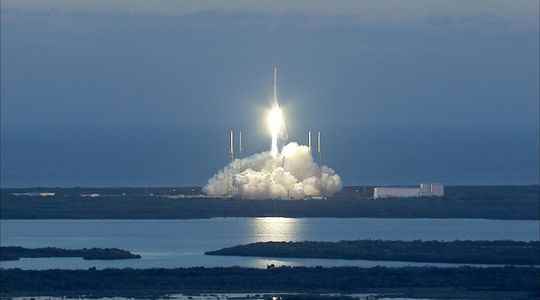Funny end to the journey for the Falcon 9 rocket. A piece of the machine designed by the American company SpaceX, plaything of Elon Musk, and used in 2015 to put into orbit a climate observation satellite on Earth, the Deep Space Climate Observatory (DSCOVR), is expected to crash into the lunar surface in March. The 4th of the month, very precisely, around 1 p.m. (French time). And it wasn’t really planned.
Why ? For seven years, this second stage of the spacecraft (in its version 1.1) had been floating in the cosmos in an orbit called “chaotic” by mathematicians, because it is difficult to predict, astronomer Bill Gray explained to AFP on Wednesday. is the first account of the new trajectory. This differs from “low orbit”, for which a large amount of debris is intended, which today generates serious dangers for astronauts sent on a mission above the Earth, via the International Space Station. Many of SpaceX’s rockets are launched less far, which usually allows the second stage to re-enter Earth’s atmosphere, where it disintegrates above the ocean. The first floor is recovered and reused. For the purposes of the mission, it had not happened that way.
This object therefore had everything to be forgotten, like his Roadster which is still floating in the cosmos, and which should approach the planet Mars by the spring of 2023. But in early January, this piece of about 4 tons passed quite close to the Moon, which changed its orbit, detailed Bill Gray, also creator of “Project Pluto”, a software allowing to calculate the trajectories of asteroids and other objects, used by observation programs financed by NASA.
A week later, the expert was able to observe the piece of rocket again, and realized that it should crash into the far side of the Moon on March 4. “I’ve been tracking space junk like this for about fifteen years, and this is the first unintended lunar impact” detected, he said.
An impact at 9000 km/h
According to astronomer Jonathan McDowell, however, it is possible that similar impacts have occurred in the past, without our knowing it. “There are at least fifty objects left in deep space in the 1960s, 1970s and 1980s, just left there, untracked,” he explained. Today’s sightings haven’t found them all. “It is likely that some hit the Moon accidentally,” he said.
Space X’s rocket tip will hit the lunar surface at over 9000 km/h. The precise time and place could still change by a few minutes and kilometers, due to the hardly predictable effect on this hollow cylinder of the light of the Sun, which pushes it in a noticeable way. The rocket stage can again be observed in early February, and the estimate refined. But the collision is certain. It will not be visible from Earth.
The anecdote is funny for the company of Elon Musk, in the process of developing the lander which should allow NASA to return Americans to the Moon, at the earliest in 2025. And a notable player in tourist space flights in front of to send the first billionaire – the Japanese Yusaku Maezawa – to take a closer look at our earth satellite by 2023.
A pretty crater in perspective
The crash of this object will still have a consequence. The latter should cause a crater which could be observed by scientists later, in particular by NASA’s LRO (Lunar Reconnaissance Orbiter) probe or the Indian one, called Chandrayaan-2, and thus make it possible to learn more about the lunar geology. At New York Times, Mark Robinson, professor of earth and space exploration at Arizona State University, said he expected a crater about 10 to 20 meters wide.
Ships have been intentionally launched on the Moon for scientific purposes in the past, such as during the Apollo missions to test seismometers. In 2009, NASA sent a second stage rocket to crash in an area near the lunar south pole to study the presence of water.
But these unplanned lunar impacts could multiply in the future, according to Bill Gray, in particular because of the objects that will be left behind by the American or Chinese lunar programs. The United States wants to build a station in orbit around the Moon. These events “will start to be problematic when there is more traffic,” pointed out Jonathan McDowell. The latter points to the time-consuming waste tracking mission in deep space. “It’s time to start regulating it.”
